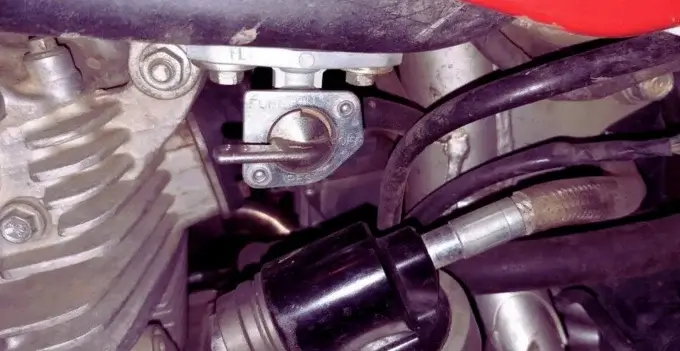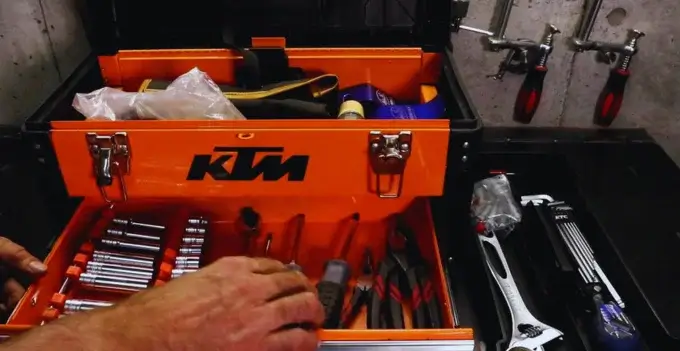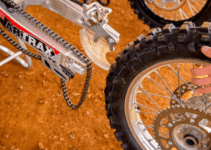A 2-stroke dirt bike flooding is more frustrating than a discontinuous WiFi connection. Flooding on a 2-stroke dirt bike can damage your day while riding off-road. Many reasons cause flooding, but its solution is very easy and get back to your joyful day.
Is your dirt bike flooded? What is its cause? How to solve this problem? This article depicts all the aspects, causes and tips to fix that problem wisely by yourself. Just keep reading so you’ll know how to start a flooded 2-stroke dirt bike in your garage.
Count on me if you need help with flooding in your 2-stroke dirt bike.
What is a Flooded Motorcycle Engine?
A flooded motorcycle or dirt bike engine refers to a situation where the engine is filled with excess fuel. Due to extra fuel in the engine or combustion chamber, the engine will not start properly. It means the fuel-air mixture is too rich with more fuel and a low air ratio.
Do You Know?
By Premix Calculator, you can easily calculate the appropriate premix for a 2-stroke engine with a gas-oil mix ratio of 50:1 or 40:1 and more.
What Happens When A Dirt Bike Floods?
I owned a 2-stroke dirt bike and flooded many times. But I resolve this problem in no time. Because I am handy in starting a flooded 2-stroke dirt bike, you should know that when a dirt bike floods, more fuel is in the engine’s combustion chamber, making it difficult for the engine to start or run.
What do you mean by the term flooding an engine? It’s crucial to understand this phenomenon. The carburetor mixes fuel with air and jets it into the engine as a fuel-air vapor mix. The spark from the spark plug much more easily ignites it. The fuel may saturate the cylinder and soaks the plug-in gas. The plug, an electrical component, struggles to work when soaked in fuel. Continuous shots handle the situation to start the engine.
What Causes A Dirt Bike To Flood?
Suppose you’re having the problem of flooding regularly with your dirt bike. The following problems could cause flooding in your 2-stroke dirt bike. Some are relatively easy to check and resolve, while others may require more in-depth intervention!
Here’re the main causes of dirt bike flooding in the engine:
1. Forgetting to close Fuel Valve.
Leaving the fuel valve open from the tank to the carburetor will cause the fuel to flow free into the carburetor and cause the bike to flood. The solution to this problem is simple. It would be best to discipline yourself to switch the petcock off whenever you stop the bike.

2. A Dirty Air Filter
Dirt bikes are ridden on muddy terrains, leading to a clogged air filter. A clogged air filter can stop airflow, causing an imbalance in the fuel-air mixture and potentially leading to a flooded engine. The solution is too much easy for it. Just clean the air filter with a brush and rinse it off. If it has become badly fouled, then replace it.
3. Faulty Spark Plug
The rough ground of the off-road track could jerk a plug and make it lose. Therefore, secure the spark plugs and try again. If there is still no spark, replace the spark plug.

4. Carburetor Tuning
Problems with the carburetor, such as a stuck float or a faulty needle valve, can cause fuel to flow into the engine, continuously causing the flood. The solution is to set the fuel-air mixture on the carburetor appropriately.
5. Too Much Oil In The Fuel
Pumping the throttle excessively before starting the engine can raise too much fuel into the combustion chamber, leading to a flooded condition. The solution is to empty your tank and refill it with the right mix ratio of the fuel-air mixture.
6. Needle And Seat Problem
A malfunctioning needle and seat valve in the carburetor can cause fuel flooding in a dirt bike. The needle and seat valve regulate fuel flow into the carburetor bowl. Over time, the needle can wear out or become damaged, leading to an imperfect seal with the seat. It can cause fuel to flow into the carburetor bowl, continuously flooding.
7. Old Standing Fuel
The volatile component of the old fuel evaporates, and a thicker messy residue remains. At the same time, this residue will still burn if you try to ignite it. It has degraded so that it will not combust in the engine. The solution is to use something other than old fuel. If the fuel is still in your bike’s tank, drain it and replace it with fresh fuel.
How Do You Tell If a Dirt Bike is Flooded?
Do you need to start your dirt bike? There can be hundreds of reasons for not starting your bike. Therefore, it is challenging to know whether it is due to flooding or anything else. But don’t worry; I suggest a few specific symptoms that can easily indicate that a flooded engine is your problem.
- Non-starting of your bike
- A strong smell of raw gas
- Gas in the air filter
- Gas dripping from the carburetor
- Gas leaking from the exhaust
- Black smoke on start-up
- Poor performance of the bike
If you observe these signs, there’s a possibility that your dirt bike’s engine is flooded. In such cases, addressing the flooding issue is recommended by following the appropriate steps to resolve the problem.
What are the Tools to Unflood a Dirt Bike?
To unflood a dirt bike, you may need the following tools:
- A set of Allen wrenches
- Philips head screwdriver
- Flathead screwdriver
- socket wrench set
- Pliers
- adjustable wrench
- Teflon tape
- Bike fuel filter
- Primer bulb
- Towel or rag
- Gasoline container or drain pan

How to Start a Flooded 2-Stroke Dirt Bike?
Have you ever started a flooded 2-stroke dirt bike? Starting a flooded 2-stroke dirt bike differs from starting a regular 2-stroke or 4-stroke engine.
1. Determine the problem.
The first step is to determine the problem causing the dirt bike to flood. There’re many possible causes:
- Clogged fuel filter: The filter can become blocked with debris, preventing fuel flow to the carburetor.
- Dirty carburetor: The dirty carburetor will not mix the air and fuel properly, leading to a flooded engine.
- Bad gas: If the gas is contaminated, it can cause the bike to flood.
- Water in the fuel: If water seeps into the fuel tank, it will reach the carburetor and cause the bike to flood.
2. Tune the Carburetor.
The best way to clean the carburetor is to clean each piece separately. You should use a carburetor cleaner or another solvent designed to clean carburetors. You can also spray it down with a carburetor cleaner. After cleaning, reassemble the separated part of the carburetor and fix it in its place. Take a run test.
If the carburetor is still not working, then consult a mechanic.
3. Check the Fuel Filter & Air Filter
Dirt bikes are made for dirt terrain riding. So they become muddy. You should check whether the fuel filter is blocked because it prevents the engine from starting. You have to clean or replace it before going for a ride.
Moreover, if the air filter is dirty or clogged, it restricts airflow and causes the engine to overheat. Use a compressor or cleaner to blow off all the dirt from the air filter. After cleaning, place it again and try for a ride.

4. Make Sure There is Enough Fuel in the Tank
The most common reason a dirt bike floods is that there isn’t enough fuel in the tank. In this way, the air enters and floods the engine. Ensure at least a quarter of a gas tank before starting the bike. You must refill the tank before starting the bike if there needs to be more fuel.
Important Note:
Spark and gas can cause ignition and damage or injuries.
5. Disconnect the Spark Plug
Inspect the end of the spark plug. If it is wet and smells strongly of fuel, your bike is flooded, and you can continue with the next steps. Removing and cleaning the spark plug is necessary for unflooding the engine. Therefore, remove the spark plug with a screw or wrench. Placing a raw towel to avoid igniting the gas would be best. Be careful not to touch the electrode ends.
6. Dry the spark plug
Now it’s time to dry it with a shop towel or clean cloth because it will likely be soaked in fuel. Use an air compressor to remove any excess fuel to be evaporated. Leave the spark plug in the sun will do the same but take a few minutes. Keep the electrode gap by measuring with guage and pliers for adjusting the plug.
Do You Know?
An average gap spec is about .028 – .032 (0.7 – 0.8 mm).
7. Leave the spark plug open for excess fuel to evaporate.
As I said earlier, when you dont have a compressor, you can place your bike to evaporate excess fuel from the spark plug.
However, care must be taken to prevent dust from entering the engine. This step may take 10 to 15 minutes to completely evaporate the extra fuel depending on how much the dirt bike is flooded.
8. Replace the spark plug.
This is the step to re-fit the spark plug in the engine. Make sure it is clean and dry. If it’s not completely dry, you may need more time before fitting it back into the engine. You may replace the spark plug with a new one. Fit the plug firmly to build a good connection.
9. Try the kickstart again to start the motor.
Last but not least, try to kickstart your 2-stroke dirt bike. You may often kickstart as the carburetor and engine are in prime condition. When the flooding is resolved, your dirt bike will start within 4 to 5 kicks.
All the above steps are the easiest to start a flooded 2-stroke dirt bike. It may take a little time.
2 Stroke versus 4 Stroke Dirt Bike; How to Fix Flooded Engine?
Here’re some differences between a 2-stroke dirt bike and a 4-stroke dirt bike:
| Features | 2-Stroke Dirt Bike | 4-Stroke Dirt Bike |
|---|---|---|
| Engine | Complete the combustion cycle in two strokes | Complete the combustion cycle in four strokes |
| Fuel/Oil Mixing | Requires fuel and oil mixture | Uses separate fuel and oil compartments |
| Maintenance | Less maintenance required | More maintenance required |
| Cost | Less expensive | More expensive |
| Weight | Lighter | Heavier |
| Power Delivery | More power | Smooth power delivery |
| Noise | Louder | Quieter |
| Speed | Faster | Slower |
It’s a piece of general information about the 2-stroke and 4-stroke dirt bikes. They may vary depending on different models.
How to fix a flooded 2-stroke and 4-stroke dirt bike engine? All dirt bikes and motorcycles have the same criteria for being flooded. Therefore, they need the same steps to unflood the engine. However, I present some basic steps to fix the flooded engines of 2-stroke dirt bikes and 4-stroke dirt bikes. Just follow these steps:
- Turn off the engine
- Remove the spark plug
- Clear the flood
- Clean/replace the spark plug
- Reinstall the spark plug
- Reconnect the spark plug wire
- Start the engine.
How to avoid flooding engines?
To avoid flooded engines, regardless of whether they are 2-stroke or 4-stroke engines, you can follow these tips to unflood your dirt bike:
- Proper warm-up: Allow the engine to warm up before riding at full throttle. It helps ensure optimal fuel combustion and prevents excessive fuel buildup.
- Avoid excessive choke: When starting a cold engine, use the choke as necessary. However, gradually reduce or turn off the choke once the engine starts to avoid an overly rich fuel mixture that can lead to flooding.
- Smooth throttle control: Practice smooth and gradual throttle control. Avoid sudden or abrupt throttle inputs that can cause an influx of fuel into the engine, potentially leading to flooding.
- Regular maintenance: Follow the manufacturer’s recommended maintenance schedule for your engine. Clean or replace air filters, fuel filters, and spark plugs at specified intervals to ensure optimal performance and fuel efficiency.
- Fuel quality and mixture: Use high-quality fuel with the octane rating fuel recommended by the manufacturer. For 2-stroke engines, ensure the correct fuel-to-oil mixture ratio is used. Avoid using stale or contaminated fuel that can affect engine performance.
- Proper storage: Follow the manufacturer’s guidelines when storing the engine for extended periods. Drain off the fuel tank or add a fuel stabilizer to prevent deterioration. Protect the engine from moisture and store it in a clean, dry location.
- Maintain carburetor settings: If your engine has a carburetor, periodically check and adjust its settings according to the manufacturer’s specifications. Proper carburetor tuning ensures the right air-fuel mixture, reducing the risk of flooding.
- Learn the starting procedure: Be familiar with the specific starting procedure for your engine. Follow the recommended steps for cold starts, warm starts, and hot starts, as outlined in the engine’s manual.
By following these tips, you can minimize the chances of engine flooding and maintain optimal engine performance.
Conclusion
How to start a flooded 2-stroke dirt bike? Starting a flooded 2-stroke dirt bike requires a careful and specific procedure to clear the extra fuel and restore engine functionality. Following the outlined steps of turning off the engine, removing the spark plug, clearing the excess fuel, and reinstalling it properly, you can effectively address a flooded engine.
It’s important to refer to the dirt bike’s manual for the recommended starting procedure and seek professional help if the issue persists. This article will help you a lot.
Be prepared for every uncertain happening!
Happy riding!
FAQs
How long to wait for a flooded engine?
When dealing with a flooded engine, it is recommended to wait briefly before attempting to start it again. The time can be different for every engine and fuel system. Typically, waiting 10 to 15 minutes allows the excess fuel to evaporate or drain away, giving the engine a better chance to start successfully.
How to start a flooded four-stroke dirt bike?
To start a flooded 4-stroke dirt bike, you must do some steps. In these steps, you must turn the engine off, remove the spark plug, clear excess fuel by kicking the engine, check and clean or replace the spark plug if necessary, reinstall the spark plug, and follow the standard starting procedure. If the issue persists, consult the dirt bike’s manual for further troubleshooting.
Is it bad if the dirt bike’s engine gets flooded?
Mostly flooding does not damage the dirt bike’s engine. But it is generally considered bad if a dirt bike’s engine gets flooded. It can lead to difficulties in starting, fouled spark plugs, and potential damage to engine components. Following proper maintenance and starting techniques are important to prevent engine flooding.
Why won’t my two-stroke dirt bike start?
A two-stroke dirt bike may fail to start due to fuel issues, spark plug problems, air filter blockage, carburetor issues, ignition system problems, compression problems, or mechanical issues. Consult a qualified mechanic for proper diagnosis and resolution.
How to start a two-stroke dirt bike without a kick start?
In case of any emergency, you can start a two-stroke dirt bike without a kickstart by
- Bump start/push start
- Roll start
- Towing start







